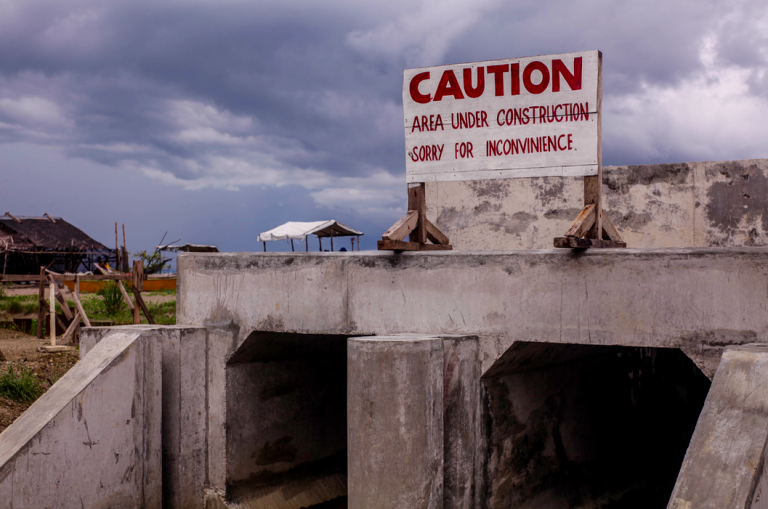
by Jolo Lim
IBON Features – Typhoon Yolanda was a disaster of epic proportions. It became an even bigger tragedy because of government neglect and corporate opportunism. Five years after the super-typhoon, a new adversary is rising for typhoon survivors that are yet to fully recover.
The Duterte administration’s Build, Build, Build program has been hyped as answering the rehabilitation and reconstruction woes of Yolanda-hit areas. But instead of rebuilding and improving people’s lives, these infrastructure projects are only adding to the economic devastation the survivors have suffered for so long.
Prioritizing tourism
The Leyte Tide Embankment Project (LTEP) is one such profit-oriented infrastructure undertaking. It will be used as a tourist attraction to lure in investors — while displacing Yolanda survivors.
The Php7.9-billion LTEP is a priority Build, Build, Build project funded by the government and developed by private entities. Designed by the Japanese International Cooperation Agency (JICA), it is a 4 meter-high seawall running 27.3 kilometers from Bgy. Diit in Tacloban City across the shorelines of Palo, and ending in Bgy. Ambao in Tanauan. The project started in 2016 and is already 70% complete, according to the Department of Public Works and Highways (DPWH) – Eastern Visayas.
The extensive seawall supposedly protects Yolanda-affected areas from future storm surges. However, the embankment project is really more about attracting investors through tourism projects and ensuring private sector profits. Palo Mayor Remedios Petilla has already spoken about how the LTEP opens the province to tourism opportunities and that the embankment itself can be a tourist attraction.
When the government declared a 40-meter “no dwelling zone” or NDZ in Yolanda-affected areas, families were prevented from returning to their homes along the shoreline. Even small businesses like sari-sari stores and small beach resorts were demolished. The access of fisherfolk to fishing grounds has also been restricted which has affected their livelihoods.
And yet big tourism establishments like the Oriental Hotel in Palo have been allowed to remain in the NDZ where the embankment is being built. The hotel is owned by the LKY Group which holds diverse business interests including SM markets, transport terminals, and McDonald’s franchises nationwide.
Slated to be accomplished by 2020, the embankment project aligns with the Duterte administration’s National Tourism Development Plan (NTDP) 2016-2022 calling for improved tourism-related infrastructure. This approach is also reflected in the Philippine Development Plan (PDP) 2016-2022 which aims to boost the country’s growth through infrastructure projects.
Undermining recovery
Instead of helping survivors to recover and rebuild, communities are being displaced and their livelihoods undermined.
Community residents interviewed by IBON complained about how project proponents and local government units (LGUs) failed to hold informed public consultations with the affected communities. LGUs also did not offer alternative livelihoods or livelihood assistance. The Center for Environment Concerns (CEC) estimates that around 10,000 families from 46 barangays will be adversely affected by the project.
The government is prioritizing funding and expediting completion of the embankment project even as many survivors have yet to receive the promised assistance and housing after five long years. About 34% of Yolanda survivors have not received the Php5,000 Presidential Financial Assistance (PFA). Also, out of 382,082 relocation housing units, only 190,413 or 50% have been completed. Of the completed units, only 76,004 or 40% have been occupied.
Agriculture and fisheries are the main source of livelihood for affected communities but these are not priorities. The budget for the Department of Agriculture in Eastern Visayas, for instance, even fell from Php1.37 billion in 2018 to Php1.35 billion in 2019. The region also faces a continued drop in agriculture production. Palay production has dropped by 4% in 2017 since 2013. There was also a 33% drop in coconut production in 2017. Fisheries volume of production in Eastern Visayas has also fallen by 21% in 2017 since 2013.
Empowering communities
There is a dire lack of social and economic infrastructure in the country. However, these should be provided to meet the needs and interests of the people and not just to give corporations opportunities for profit. It is likewise with tourism that can only be a tool for development if designed properly.
The government must be reminded about the hazards of corporate-driven tourism. If tourism is overly commercialized, the gains from tourists and tourism-related infrastructure are largely captured by the large local and foreign investors who dominate the tourism sector. Even the supposed employment gains for communities are hollow as commercial tourism exploits the cheap labor force of developing countries. Peasants and fisherfolk displaced by tourism development projects are turned into guides, waiters, cooks, and sales helpers. Profit-driven tourism is inevitably more exploitative than pro-poor or redistributive.
A good alternative to commercial tourism is backyard tourism. This community-oriented alternative does not necessarily need additional huge infrastructure to be built and generally preserves an area’s natural characteristics and environment. It also intrinsically relies on services and accommodation provided by residents.
It is important to involve the locals in decisions over projects affecting them. For example, they are in the best position to determine what kind of infrastructure their community needs – from sturdy shelters and evacuation sites, schools, hospitals, and transport, to water systems, livelihood facilities, and local factories. The government should ensure that communities and not corporations gain from these projects first and foremost.
Ultimately, government needs to assess the purpose of its current massive infrastructure program. Infrastructure development that is geared towards profitability contradicts and undermines how infrastructure should most of all be for community empowerment and genuine poverty alleviation. ###